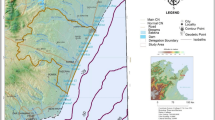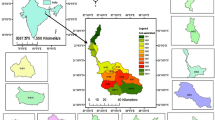Abstract
Shoreline change at various spatial and temporal scales on sandy beaches depends on coastal morphology and dynamics. However, anthropogenic activity has changed the way in which coastal geomorphology influences the trend of beach erosion processes. Coastal responses to the different influencing factors are important for decision makers to manage the risks in a sustainable coastal development framework. This paper discusses a methodology based on two complementary approaches; the combined use of satellite imagery, GIS, DSAS statistical methods and a mineralogical and granulometric characterization of beach sediments by analyzing the spatial evolution of sand characteristics. In this context, we sought to identify from a geomorphological, sedimentological and hydrodynamic viewpoint the factors affecting the central zone of the Algerian coastline by the beach and to evaluate the impact of developments on their evolution and balance. For this purpose, a 17-year historical time series on the shoreline is analysed, in order to obtain recent evidence of erosion/accretion trends. We used mathematical morphology to transform RGB satellite images of very high spatial resolution into shorelines. For granulometric changes and mineralogical composition of beach surficial sediments, a sampling campaign was carried out for one beach along 17 profiles perpendicular to the shoreline. Thus, we monitored the trace metal concentrations by X-ray diffraction. The results show that the study area exhibits a wide variety of shoreline trends. This study showed that there is a concordance between the distribution of wave energies and the coastline evolution. The results relating to the granulometric indices and their distributions showed that they are generally medium-sized sands, well classified and almost symmetrical in the eastern sector of the beach and mixed facies in the western sector. However, variability in the spatial distribution of sand grains highlights the combined effect of hydrodynamic agents and sediment sources. The evidence of sediment dynamics and the statistical study of heavy metals corroborate the results both qualitatively and quantitatively, allowing us to identify coastal erodibility in the area.
















Similar content being viewed by others
Availability of data and material
All the data presented in this manuscript can be shared with scientists in the field.
Code availability
The software used in this study is open source.
References:
Aagaard T (2014) J Geophys Res Earth Surf (1):913–926
Aagaard T et al (2004) Sediment supply from shoreface to dunes: linking sediment transport measurements and long-term morphological evolution. Geomorphology 60:205–224. https://doi.org/10.1016/j.geomorph.2003.08.002
Amarouche K et al (2017) Development of a numerical code to simulate the hydrodynamic energy potential, applied at Bou Ismail bay. Revue Des Energies Renouvelables 20(3):377–388
Amarouche K et al (2019) Evaluation of a high-resolution wave hindcast model SWAN for the West Mediterranean basin. Appl Ocean Res 84:225–241. https://doi.org/10.1016/j.apor.2019.01.014
Amarouche K et al (2020) Wave energy resource assessment along the Algerian coast based on 39-year wave hindcast. Renew Energy. https://doi.org/10.1016/j.renene.2020.02.040 (Elsevier Ltd)
Aouiche I, Daoudi L, Ihbach F et al. (2016) ‘Caractérisation minéralogique et granulométrique des sédiments littoraux de la baie d ’ Agadir ( Maroc atlantique ): dynamique sédimentaire et sources des matériaux Mineralogical and grain size characterization of coastal sediments of the Agadir bay. Sed J Mater Environ Sci 7(10): 3711–3723. http://www.jmaterenvironsci.com.
Aouiche I, Daoudi L, Anthony EJ et al (2016b) Geomorphology anthropogenic effects on shoreface and shoreline changes: input from a. Geomorphology 254:16–31. https://doi.org/10.1016/j.geomorph.2015.11.013
Benkhattab FZ et al (2020) Spatial–temporal analysis of the shoreline change rate using automatic computation and geospatial tools along the Tetouan coast in Morocco. Nat Hazards 104(1):519–536. https://doi.org/10.1007/s11069-020-04179-2 (Springer, Netherlands)
Blott SJ, Pye K (1986) Preface. Dev Water Sci 26(1):1237–1248. https://doi.org/10.1016/S0167-5648(08)70015-7
Del Río L, Gracia FJ, Benavente J (2013) Shoreline change patterns in sandy coasts. A case study in SW Spain. Geomorphology 196:252–266. https://doi.org/10.1016/j.geomorph.2012.07.027
Dolan R, Fenster M, Holme S (1992) Spatial analysis of shoreline recession and accretion. J Coastal Res 8(2):263–285
El Mrini A et al (2012) Beach-dune degradation in a Mediterranean context of strong development pressures, and the missing integrated management perspective. Ocean Coast Manag 69:299–306. https://doi.org/10.1016/j.ocecoaman.2012.08.004
El-Asmar HM, Hereher ME, El Kafrawy SB (2013) Surface area change detection of the Burullus Lagoon, North of the Nile Delta, Egypt, using water indices: a remote sensing approach. Egypt J Remote Sens Sp Sci 16(1):119–123. https://doi.org/10.1016/j.ejrs.2013.04.004
Fadhli FZ, Bachari NI (2016) Geographical objects extraction combining fuzzy logic and high resolution RGB image. Int J Imaging Robot 16(2):17–34
Faye IBN, Hénaff A, Gourmelon F (2008) Évolution du trait de côte à Nouakchott (Mauritanie) de 1954 à 2005 par photo-interprétation. Norois 208:10–28. https://doi.org/10.4000/norois.2146
Folk RL, Ward WC (1957) Brazos river bar: a study in the significance of grain size parameters ward bar also afforded an opportunity to study the reason for the peculiar, almost universal lack of sedimentary particles in th. J Sediment Petrol 27(1):3–26
Ford M (2013) Shoreline changes interpreted from multi-temporal aerial photographs and high resolution satellite images: Wotje Atoll Marshall Islands. Remote Sens Environ 135:130–140. https://doi.org/10.1016/j.rse.2013.03.027
Genz AS et al (2007) The predictive accuracy of shoreline change rate methods and alongshore beach variation on Maui Hawaii. J Coast Res 231:87–105. https://doi.org/10.2112/05-0521.1
Hakkou M et al (2019) Assess and mapping the flooding hazards using geospatial tools and empirical model along Kenitra coast, Morocco. Ocean Coast Manag 169:264–272. https://doi.org/10.1016/j.ocecoaman.2018.12.032 (Elsevier)
Kermani S et al (2016) Detection and analysis of shoreline changes using geospatial tools and automatic computation: case of jijelian sandy coast (East Algeria). Ocean Coast Manag 132:46–58. https://doi.org/10.1016/j.ocecoaman.2016.08.010 (Elsevier Ltd)
Komar P (2000) Coastal erosion—underlying factors and human impacts: shore & beach. Shore Beach 68(1):3–16
Maiti S, Bhattacharya AK (2009) ‘Shoreline change analysis and its application to prediction: a remote sensing and statistics based approach. Mar Geol 257(1–4):11–23. https://doi.org/10.1016/j.margeo.2008.10.006
Nordstrom KF (1977) The use of grain size statistics to distinguish between high- and moderate-energy. Beach Environ 47(3):1287–1294
Ojeda Zújar J et al (2002) Monitoring morphological changes along the coast of Huelva (SW Spain) using soft-copy photogrammetry and GIS. J Coast Conserv 8(1):69–76. https://doi.org/10.1007/BF02806586
Paskoff R (1994) Les littoraux Impact des aménagements sur leur évolution. p 256
Rasuly A, Naghdifar R, Rasoli M (2010) Monitoring of Caspian Sea coastline changes using object-oriented techniques. Procdia Environ Sci 2:416–426. https://doi.org/10.1016/j.proenv.2010.10.046
Remmache K et al (2020) Granulometric indices mapping in relation to hydrodynamic factors for beach characterization and monitoring with very high spatial resolution. Data Sci Appl 3(1):5–12
Robinet A (2016) Statistical modeling of interannual shoreline change driven by North Atlantic climate variability spanning 2000–2014 in the Bay of Biscay. Geo Mar Lett. https://doi.org/10.1007/s00367-016-0460-8
Sahu BK (1964) Depositional mechanisms from the size analysis of clastic sediments. J Sediment Petrol 6(7):73–83
Scott DB (2005) Coastal changes, rapid. In: Schwartz ML (ed) Encyclopedia of coastal sciences. Springer, The Netherlands . https://doi.org/10.1007/1-4020-3880-1_76
Sherman DJ, Bauer BO (1993) Coastal geomorphology through the looking glass. 7:225–249
Slott JM, Murray AB, Ashton AD (2010) Large-scale responses of complex—shaped coastlines to local shoreline stabilization and climate change. J Geophys Res Earth Surf 115:1–19. https://doi.org/10.1029/2009JF001486
Thieler ER et al (2005) The digital shoreline analysis system (DSAS) version 3.0, an ArcGIS© Extension for Calculating Historic Shoreline Change. U.S. Geological survey open-file report 2005–1304
ER Thieler, EA Himmelstoss, JL Zichichi, A Ergul (2009) The digital shoreline analysis system (DSAS) version 4.0—an ArcGIS Extension for Calculating Shoreline Change. US Geological Survey Open-File Report 2008–1278
Verpoorter C (2009) Télédétection hyperspectrale et cartographie des faciès sédimentaires en zone intertidale: application à la Baie de Bourgneuf
Zuzek P, Nairn RB (2003) Spatial and temporal considerations for calculating shoreline change rates in the Great Lakes Basin
Funding
No funding was received to assist with the preparation of this manuscript.
Author information
Authors and Affiliations
Contributions
All authors contributed to the study conception and design. Material preparation, data collection and analysis were performed by [KR], [NEIB], [MA], [KK] et [FH]. [KR] wrote the first draft of the manuscript and all authors commented on previous versions of the manuscript. All authors read and approved the final manuscript.
Corresponding author
Ethics declarations
Conflict of interest
The study does not present any conflict of interest.
Ethics approval
‘Not applicable’ for that section.
Consent to participate
The authors contributed by consent.
Consent for publication
The authors approved the study for publication.
Rights and permissions
About this article
Cite this article
Remmache, K., Bachari, N.E.I., Ayache, M. et al. Combination of Multi-source Data and Multi-application Models to Develop a Methodology as a Qualitative Study for Beaches with very High Spatial Resolution. Earth Syst Environ 5, 767–783 (2021). https://doi.org/10.1007/s41748-021-00239-0
Received:
Revised:
Accepted:
Published:
Issue Date:
DOI: https://doi.org/10.1007/s41748-021-00239-0




